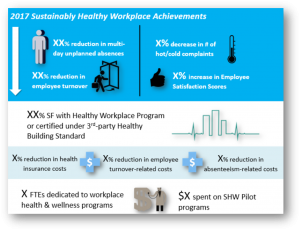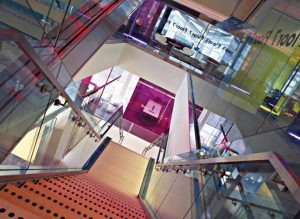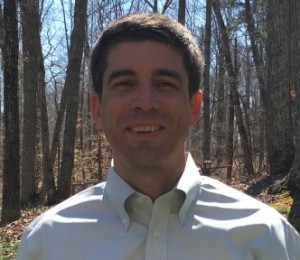This website uses cookies so that we can provide you with the best user experience possible. Cookie information is stored in your browser and performs functions such as recognising you when you return to our website and helping our team to understand which sections of the website you find most interesting and useful.
October 3, 2018
SR Inc’s Q3 Executive Symposium Zeroes In On Benchmarks for Sustainably Healthy Workplaces
Sustainability Roundtable, Inc. (SR Inc) was pleased to host Executives for its 3rd quarter Symposium during Climate Week in New York City at Member-Client Bloomberg’s Midtown office. During the meeting, SR Inc and Member-Clients built upon the first 2 Symposia of 2018 (which centered on guidance for goal-setting and prioritizing initiatives) to focus on high-performance benchmarks of a Sustainably Healthy Workplace (SHW).
Jim Boyle kicked off the conversation with a discussion of the day’s Key Takeaways, which are summarized below:
- Companies that don’t currently have a health and productivity strategy are increasingly recognizing the need to develop one and align it with their Corporate Sustainability programs
- Member-Clients are leveraging SR Inc’s Playbook for Sustainably Healthy Workplaces to clarify correlations, quantify impacts, develop financial methodology, & make the business case for SHW worldwide
- Member-Clients are improving their communications to employees when implementing SHW initiatives that impact their interaction with workplace, including working with SR Inc to develop Results Reports
- Member-Clients are selecting a small number of high-impact/high-visibility SHW initiatives to implement across their portfolio based on available data & current resources to support baselining and goal-setting
- Member-Clients are leveraging leadership standards such as Fitwel, WELL and LEED to identify average & high-performance benchmarks for selected metrics, such as acoustics, air quality, and lighting
Jim also noted the global momentum for SHW strategies, citing a survey of over 1,600 employers, 44% of which had a health and productivity strategy in 2016 versus 92% that planned to have a strategy in place within 2 years.
Following Jim’s introduction, Kelsey Wallace, SR Inc’s Sr. Manager of Research & Consulting, took the mic to remind Member-Clients of SR Inc’s Playbook for Sustainably Healthy Workplaces, which the firm developed in response to the growing interest of Member-Clients in developing a SHW strategy customized for their company. SR Inc developed this Playbook in partnership with Delos, developer of the WELL Building Standard, as well as other Industry Experts and Member-Clients, and is continually helping Member-Clients to implement the Guidance and Tools therein at their own companies.

The Playbook is organized into 5 modules that guide managers through the process of evolving their existing corporate sustainability programs to integrate and elevate employee health and wellness. One key component of the Playbook is the Reporting module, which provides template tools for companies to leverage in tracking and reporting performance on the SHW metrics they’ve selected for their program. The graphic at right shows an example template, though SR Inc team members regularly develop customized reports to promote clients’ SHW programs internally and externally.
Of course, most managers don’t have time to track/report on the 100+ metrics that WELL and others have identified as relevant for scoring relative health in the built environment. Thus, many management decisions go into choosing the right metrics to track/report across the portfolio, e.g.
- Which metrics are most easily quantified?
- Which metrics matter most in the knowledge workplace environment?
- Which metrics can be impacted in leased space?
Although a wide array of sub-categories and related metrics are used to measure performance on key features of a SHW (e.g. Acoustics, Air Quality, Thermal Comfort, etc.), for the sake of grounding this discussion in some practical engineering, Kelsey presented three example metrics and corresponding benchmarks that Member-Clients find interesting when defining the SHW.
- Acoustics: Noise Criteria (NC) is numerical rating system used to specify background sound levels over a specified frequency range – typically used to rate the relative loudness of ventilation systems. WELL requires open offices to have NC < 40, citing the General Services Administration’s (GSA) “Sound Matters” report (GSA is a co-creator of Fitwel.)
- Indoor Air Quality (IAQ): One key IAQ metric of interest to Member-Clients is Volatile Organic Compounds (VOCs) levels, for both the obvious compliance reasons as well as their relationship to Materials Red Lists, an issue of increasing interest to Member-Clients. Both LEED and WELL define healthy VOC levels as those <500 μg/m³.
- Lighting: A third metric Member-Clients find relevant when evaluating SHW performance is presence of Circadian Lighting, or Equivalent Melanopic Lux (EML). Circadian lighting may incorporate daylighting but can also be independent of daylighting with the right electric light. Therefore, this metric can be controlled independent of other management decisions related to daylight access. The connection between Circadian Lighting and alertness, happiness, and productivity and relatively easy to understand and thus resonant with employees. WELL proposes EML as a metric of Circadian Lighting in the workplace, as it is weighted to the part of the eye that impacts how alert or tired we feel.
Member Client Leadership

Michael Barry, Head of Sustainable Business Operations, Global Sustainability at Bloomberg, kicked off the Member-Client presentations with a discussion of Bloomberg’s strategy regarding 3rd party building certifications.
- Bloomberg is the global financial information and news leader, with more than 19,000 employees in 204 offices globally supporting 4 lines of business: Bloomberg Terminal, Enterprise Services Verticals, and News and Media. The Sustainability department was formed in 2007 and focuses on all aspects of the company – people, planet, and products.
- Bloomberg aims to certify its workspaces wherever possible to promote transparency and systematic tracking, i.e. prove the space is performing as designed/marketed.
- Bloomberg worked with its landlord to achieve Fitwel certification for its headquarters in NYC. The Fitwel scoring method aligned closely with Bloomberg’s existing strategy around healthy workplaces.

Bloomberg’s Fitwel certified Headquarters at 731 Lexington Ave., NYC - Bloomberg’s extensive experience with LEED and BREEAM helped it to sell Fitwel certification internally and prepare for the rigors of another certification scheme.
Following Michael’s contribution, Hakon Mattson, Anthem’s Director of Sustainability, provided an overview of Anthem’s strategy for promoting employee health and wellness across its portfolio.
- Anthem is a Fortune 29 company with 58,000 employees across ~10 M ft² space. Anthem recently achieved the 94th percentile on the Dow Jones Sustainability Index for the healthcare industry, validating the company’s SHW strategy and earning positive attention from Anthem’s senior leadership team.
- Anthem’s strategy for integrating its Sustainable, Healthy Built Environment strategy with its Corporate Sustainability strategy is being informed by SASB’s recommended material indicators for Managed Care, as well as the UN’s Sustainable Development Goals.
- Anthem has a board-level mandate for LEED certification for all new construction and has chosen to pair LEED with Fitwel certification to ensure health and wellness considerations are elevated in the design and build process.
- Anthem has developed a best practice strategy of pairing Fitwel certification with 3rd-party performance audits by a contracted Industrial Hygienist. This strategy leverages specific components of leading 3rd party best practice/certification systems for a holistic approach that allows Anthem to cost-effectively benchmark and certify all buildings across its portfolio.
- Hakon highlighted a number of features of the built environment that Anthem aims to incorporate across all workplaces, including innovative ways to get employees more active, staying hydrated, eating well, and connecting with nature.
SR Inc looks forward to continuing the collaboration with Member-Clients throughout the remainder of 2018 to share specific stepwise guidance for implementing a SHW strategy based on best practices that Member-Clients have identified. We look forward to our Q4 Symposium in San Diego on Friday, December 7th. In the meantime, don’t hesitate to contact us to discuss how we can help you develop, drive, and/or report on an SHW program at your company.
Select Relevant SBER Executive Guidance & Tools:
- 2018 Symposia Presentations:
- 2018 Q3 ES: Sustainably Healthy Workplaces Worldwide: Guidance for Benchmarking Your Portfolio
- 2018 Q2 ES: Sustainably Healthy Workplaces Worldwide: Guidance for Setting Goals & Prioritizing Initiatives
- 2018 Q1 ES: Sustainably Healthy Workplaces Worldwide: Guidance for Segmenting Portfolio & Selecting Metrics
- Member Executive Tools:
- Member Advisories:
- Member Briefings:
- Member SBER Full Reports:
 As Senior Manager of Research & Consulting, Kelsey Wallace supports members of SR Inc’s confidential, strategic advisory & support service in their move to more sustainable high-performance. With several years experience at the intersection of business and sustainability, Kelsey provides specialized program assistance to clients on a one-to-one basis, supporting all aspects of strategy development and implementation for management teams overseeing corporate sustainability strategies, policies and projects. Prior to joining SR Inc, Kelsey worked for The Cadmus Group, where she provided technical support to the Environmental Protection Agency and US Green Building Council on projects to improve the sustainability of federal infrastructure. Kelsey also devoted a year to national service with the AmeriCorps National Civilian Community Corps, where she worked on team-based conservation and community development projects throughout the Southwest United States. Kelsey has her B.A. in Environmental Studies from Connecticut College.
As Senior Manager of Research & Consulting, Kelsey Wallace supports members of SR Inc’s confidential, strategic advisory & support service in their move to more sustainable high-performance. With several years experience at the intersection of business and sustainability, Kelsey provides specialized program assistance to clients on a one-to-one basis, supporting all aspects of strategy development and implementation for management teams overseeing corporate sustainability strategies, policies and projects. Prior to joining SR Inc, Kelsey worked for The Cadmus Group, where she provided technical support to the Environmental Protection Agency and US Green Building Council on projects to improve the sustainability of federal infrastructure. Kelsey also devoted a year to national service with the AmeriCorps National Civilian Community Corps, where she worked on team-based conservation and community development projects throughout the Southwest United States. Kelsey has her B.A. in Environmental Studies from Connecticut College.


